Water and Climate in the Himalayas
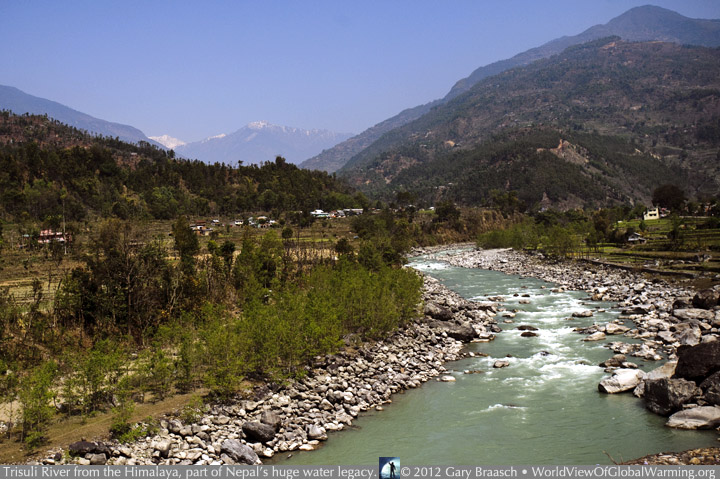
The mountainous states of India, and the nations of Nepal and Bhutan share one of the world’s greatest freshwater resources -- water from the snows of the Himalayas and the monsoons which the mountains create. More than 1.4 billion people depend on water from the rivers of the Himalaya, with the eastern rivers like the Ganges much more dependent on rain and groundwater than on direct flow from glaciers. Glacier melt is only 4 percent of the annual 220,000 billion cubic meters of flow for the rivers of Nepal, which feed the Ganges, as estimated in a recent report. One of these rivers is the Trisuli, in this photograph flowing down past Betrawati from the Langtang region of central Nepal.
On a recent journey to Uttarakhand, India, and Nepal, with support from the Karuna Foundation US, the use of water and its abundance, scarcity and quality as our climate changes was crucial everywhere we went. The photos and research presented here were made through the gracious cooperation of the Uttarakhand Environmental Education Center (UEEC), World Wildlife Fund - Nepal (WWF), and The Mountain Institute. Additional information is from International Centre for Integrated Mountain Development (ICIMOD) reports, other NGOs and press reports.
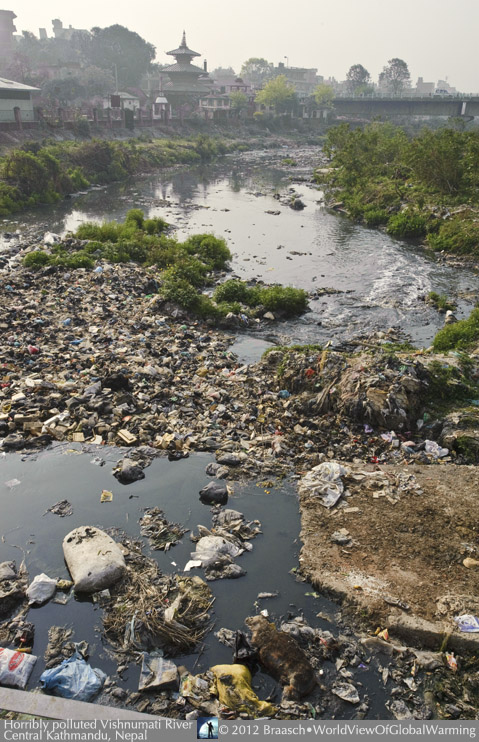
Water flowing down from the Himalaya is mostly abused and polluted as it flows through the cities, even though the water is needed for human use. In Kathmandu, rivers like the Bagmati and its tributary the Vishnumati (also called Bishnumati), seen here, are public and industrial dumps of every kind of waste, despite frequent public awareness campaigns and periodic clean up attempts. As the Nepal Times put it, “The Bagmati River is an open sewer.” Nevertheless, people use the water for washing, household use, rituals, and for funeral ceremonies at ghats, including at the holy Hindu temple of Pashupati. The Bagmati is a snow- and rain-fed, not glacial river, and the Vishnumati, only 18 km long, is entirely supplied by rain and groundwater.
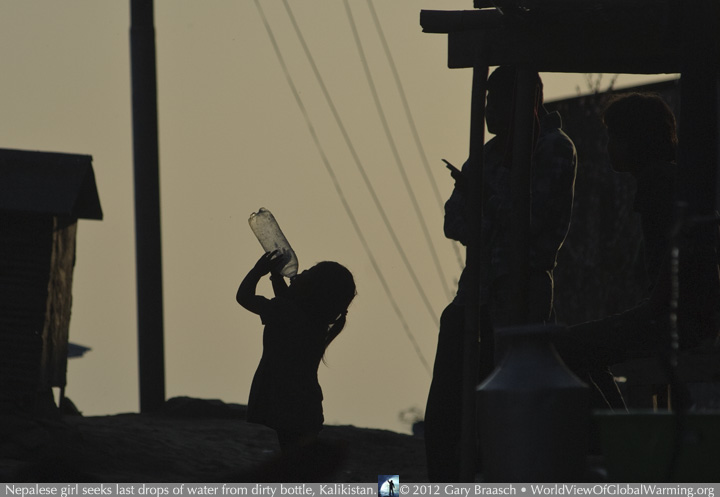
Nepal is extremely rich with water, with more than 6,000 rivers and the rains of the monsoon. Yet, according to a report by the International Water Management Institute, more than a quarter of the 29 million population has no access to safe drinking water and “little consideration is given to environmental requirements.” In the Himalayan foothills, where rivers and groundwater are much less polluted than in the cities and valley, seasonal water shortages and lack of safe in-home water supply nevertheless affect most people. We saw families and mothers stooped over to fill bottles, jugs and pans with water leaking from pipes that were snaking down dirt streets in the village of Kalikistan, Rusuwa, Nepal. The pipes supply the village of Jibjibe, but leaks spurted and dripped along the 2 km route, part of which was temporarily suspended across a raw landslide scar (see the Landslides photo set for more about this).
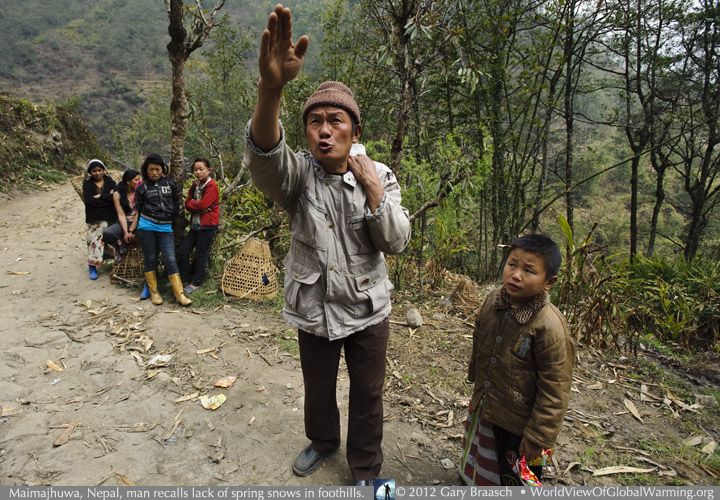
Gesturing broadly up to the surrounding mountains, primary school teacher Dessli Rai of the village of Torke Maimajhuwa, Nepal, tells us there are now no long-lasting snows after winter and thus much less water in the spring pre-monsoon season. The 50-year-old said the change has been noticeable for more than a decade but seems to be increasing. Small streams flowing down from the hills in this area north of Ilam now are drying up, “completely finished, day by day,” in March instead of flowing for two more months. His observations were commonly repeated by others we met in the region: It used to snow heavily at around 2400 m and below, up to a meter in depth and the snow would remain to provide meltwater over several months. In the neighboring Indian state of Uttarakhand, “it never snows in Almora anymore,” said Anuradha Pande of the UEEC. Recent studies reported by ICIMOD found that it has not snowed in Almora, eleveation 1600 m, for 3 to four years and that the lack of snow at medium elevation locations removed “an important source of water for agriculture.” Farmers reported “delayed and erratic rainfall during the rainy season followed by prolonged dry periods.”
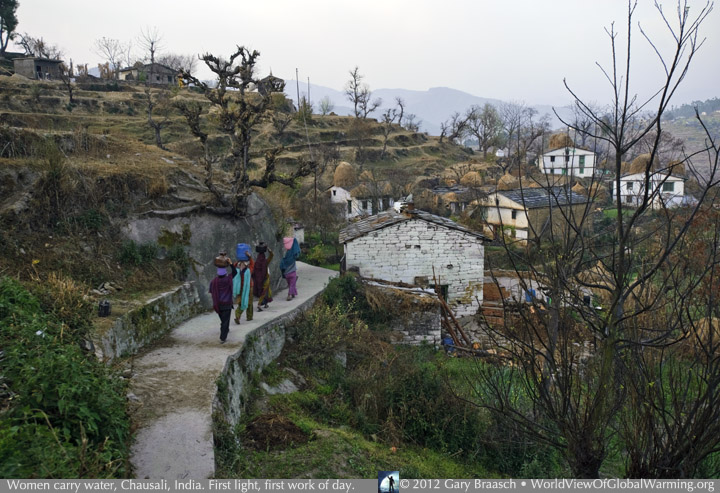
In the dawn, four women carry water containers from a spring into the village of Chausali, near Almora, Uttarakhand, India. Women are particularly affected by climate changes due to their daily work which includes getting water, collecting forest wood and fodder, and working in dangerous landslide areas near villages. Researchers of the Indi-German Environment Programme found that, “In the fragile ecological zone in the hilly areas of Uttarakhand, human activities, including agriculture, cause extensive land degradation which, in turn, adversely affect water retention and recharge. The problem of water shortage, exacerbated by extreme weather events such as erratic rainfall, cloudbursts, unpredictable temperatures, etc. leads to detrimental effects on agriculture, forestry” and even manufacturing.
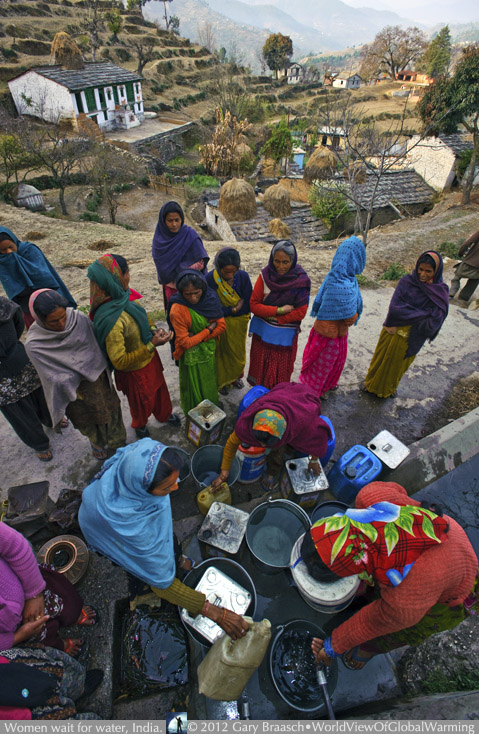
More than 15 women wait as a very slow flow from another spring in Chausali, India, fills their water containers. Several springs in this area have dried up, causing the community to change the traditional division among castes. Women here are limited to filling one container a day. Previously different castes used separate springs, but now upper and lower castes are using the same water sources. Across similar Himalayan foothills areas, inhabitants told ICIMOD researchers in 2011 that local drinking water sources seemed to be drying up; and “on average, they reported a 50 percent decrease in drinking water sources.”
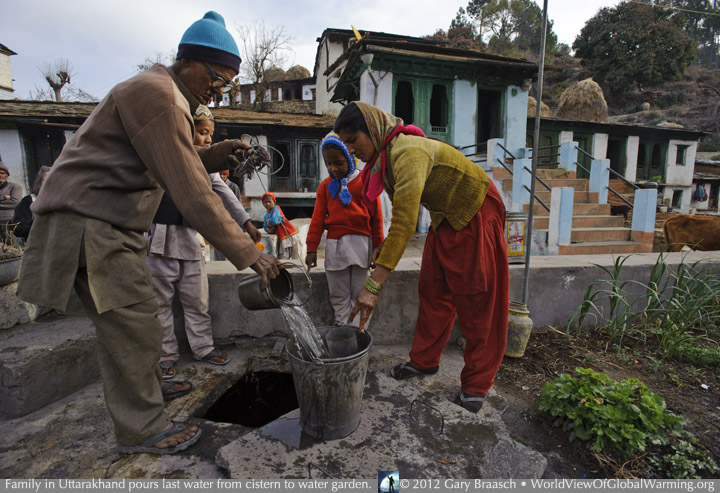
The last of the water from a cistern in Chausali village is drawn up by Bhem Singh Latwal and his wife Kamla Latwal in early March -- a time when late winter rains would be expected to have at least partially refilled the underground tank. But in recent years winter rain is scarce, they said. This cistern, fed from rain falling on roofs of the family buildings, was built in 1952 to supply livestock and irrigate the garden. Recent aid from the Indo-German Environment Program through UEEC in the Almora area has helped build new water-conservation facilities like erosion control dams, rooftop rainwater harvesting systems, rejuvenation of springs and catchment areas. The goals of this and other UEEC work include increased availability of drinking and agricultural water, increased soil moisture, and reduced health impacts of drought.
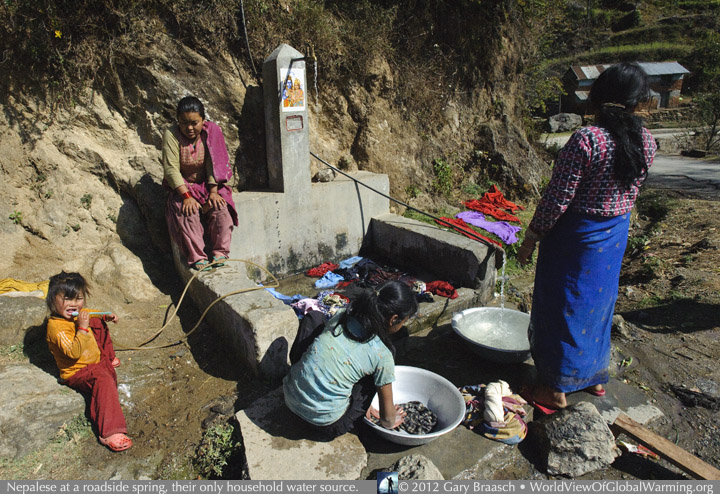
Throughout the Himalayas, most people in villages do not have piped in water but must rely for household use on public roadside taps from springs or catchments. Many community water sources are drying up in the foothills and mountainous regions of Nepal at the same time that regional temperatures are rising at a rapid rate. Studies published in 2011 showed that the “region is one of the world’s hotspots in terms of warming trends.” An ICIMOD report on water in the Himalaya said that the mean maximum temperature in Nepal increased by 0.06 degrees C per year between 1977 and 2000 -- equivalent to more than a degree F per decade. In Nepal just as in India, there are already signs of changes in the dates of the onset and retreat of the monsoon as well as the number and frequency of extreme precipitation events, according to scientific research published by ICIMOD.
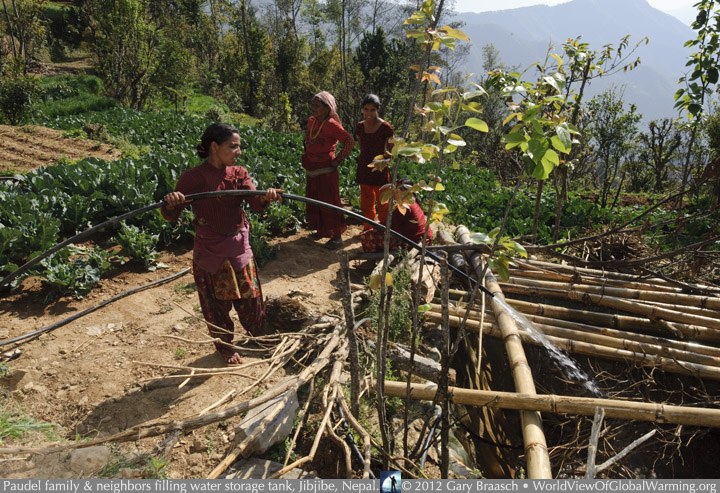
In the Nepalese village of Jibjibe, a Village Development Committee of Rasuwa District, the family and neighbors of farmer Bhawanath Paudel fill a hand-dug water storage pond. Jibjibe is a village of about 4,000 people which like many mountain hamlets spreads down a steep hillside notched by agricultural terraces above the Phalankhu River. Over the years the townspeople have dealt with uncertain water supplies by building three reservoirs, the water from which runs down past houses in small pipes but is rationed during droughts. When water is flowing, farmers irrigate their vegetable crops like onions, peas, tomatoes, mustard and cabbage and fill small ponds to save the water. Locally-run programs in farmer education, climate change education, and water management have advanced with advice and encouragement of the World Wildlife Fund.
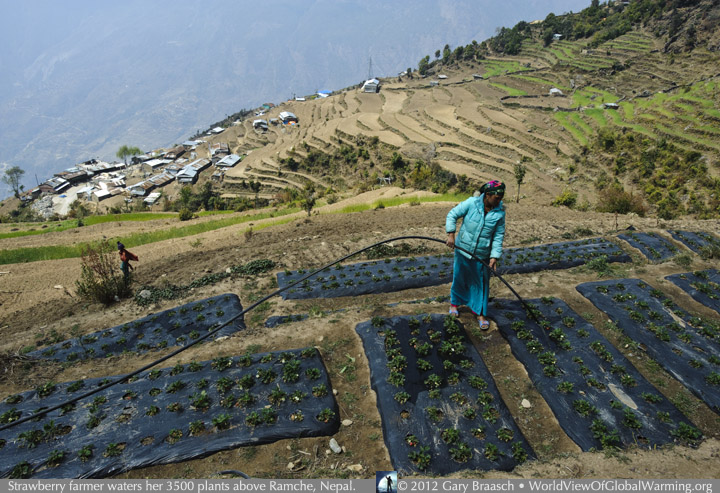
“Village of Landslides” is one local name now for Ramche, a Village Develpment Committee in Rasuwa District, Nepal, where a huge landslide is actively eroding around parts of the village (see adjoining portfolio on Landslides for more information). Far above the road and center of the village, a far-sighted woman farmer is experimenting with strawberries as new cash crop, trying to roll with the one-two punch of warmer and dryer climate and damage to springs from the landslide. With her own experience aided by knowledge from a WWF-sponsored Farmer School, Mempayhelmo Tamang has instituted water collection, composting and waste management along with her new berry beds.
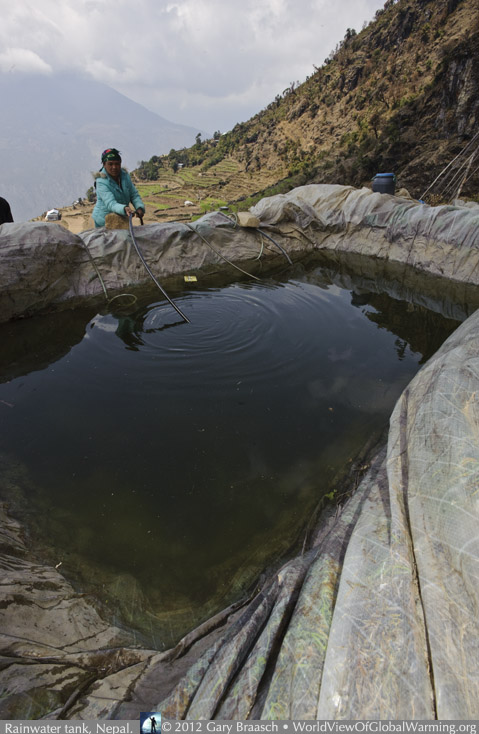
Farmer Mempayhelmo Tamang told WWF that it used to snow heavily in her village till a few years ago. “When it snowed in winter, it was helpful for wheat and mustard farming.” When it didn’t snow, the farming dried up, she said. So in response, and in an attempt to make more money from her terraces, she began the initiative to plant 3500 strawberry seedlings -- the first farmer in the area to try this. A year before she had dug this rainwater collection pond and lined it with plastic provided by WWF. Throughout the region, encouraged by the NGOs, farmers are digging more water collection ponds both unlined, to help return water to the ground, and lined with plastic to retain water for irrigation and animals.
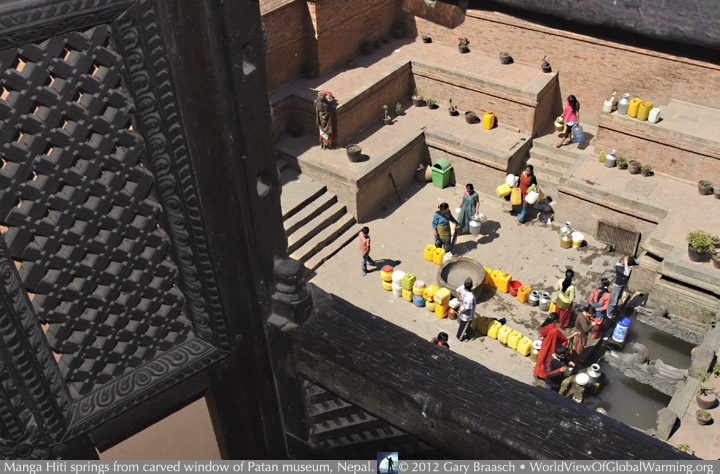
Drought and diminishing aquifers plague the Kathmandu Valley as they do the foothills above. Photographed looking down from the traditional carved windows of the Patan museum, the sunken courtyard and water spouts of the Mangna Hiti are also part of Nepal’s living urban history. “Hiti” is a Newari word for “stonespout,” the outlet of a unique water harvesting system developed in the 6th century AD to provide domestic water to residents. The system channels water from springs or a shallow aquifer, and canals and ponds were built later to recharge the aquifers from surrounding hills. Water is known to Hindus and Buddhists of Nepal as the gift of the Nagas, the snake dieties which bring rain and protect springs. Thus hitis usually have spouts and carvings shaped like snakes, and have great cultural, religious and archeological significance.
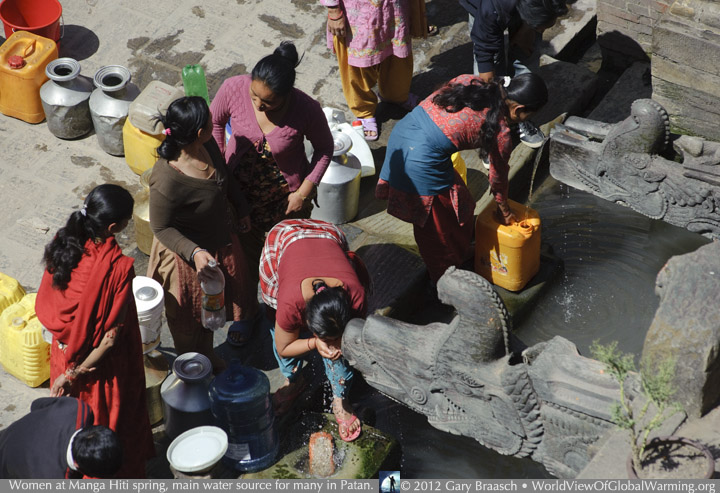
Women gather daily at Manga Hiti in Patan, along with some family members, to fill water containers for household use. According to a UN-Habitat report “Water Movement in Patan” and survey reports, water from hitis serves more than ten percent of Kathmandu Valley population -- perhaps as many as 400,000 people at some times. There are almost 400 hitis in the valley, but only 233 of them were working as reported in a 2010 survey. Another forty were connected to city water rather than natural springs and more than 100 were inoperative or had been destroyed during urban development or through disuse. Neighborhoods have frequently worked to restore and clean their hitis.
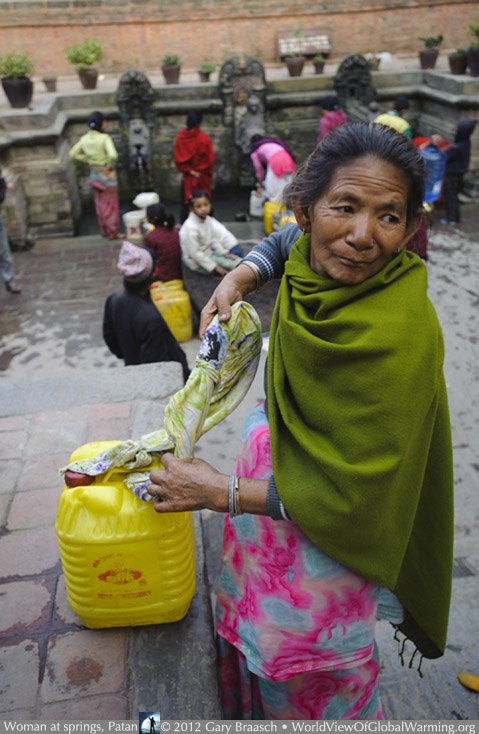
Manga Hiti, very most prominent because of its location in the Patan Durbar Square, was renovated in 2010 by the Lalitpur area improvement committees. They keep watch over the hiti to insure cleanliness and order. But users like this woman about to lug her water up the stairs are not insured abundant healthful water. Population increases and agricultural irrigation in the valley have caused the aquifer and surface water to be over used and pumped down. And a recent “Microbiological Analysis of Drinking Water of Kathmandu Valley” by Tista Prasai and colleagues, evaluated water from hitis as well as wells and city taps in Kathmandu. The plate and coliform count revealed that more than 80 percent of drinking water samples were found to exceed the WHO guidelines for safe drinking water. Other studies published by ICIMOD show that chemical pollutants such as arsenic, ammonia, and nitrate lurk in deep aquifers in many areas of the Valley.
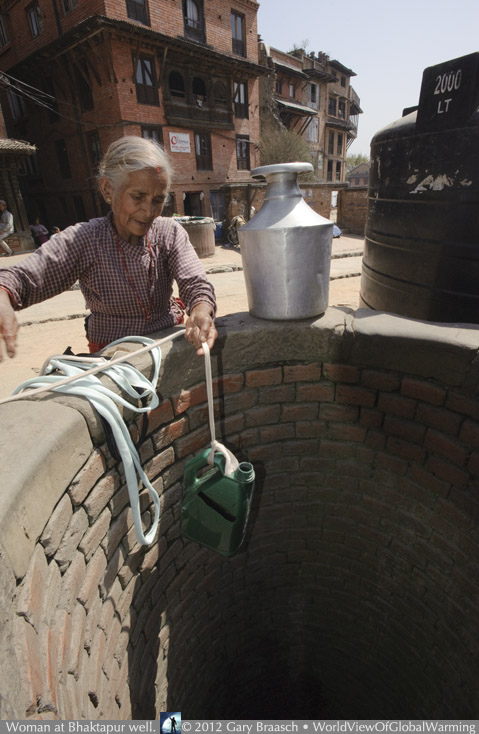
Well water has been the saving grace for as many as 80,000 people in Kathmandu and the Valley according to water use surveys, but that resource, too, is diminishing. In Bhatapur, where this woman was finding water only at the stony bottom of a 25 foot hole that stank a bit of sewage, there are 152 wells and 34 open ponds which serve those who have no home piping. Wells are also source of about half the public water supply. According to an article in the Kathnamdu Post, the aquifer is being pumped out at twice the recharge rate and the depth where new wells find water has dropped from 20 feet to more than 40.
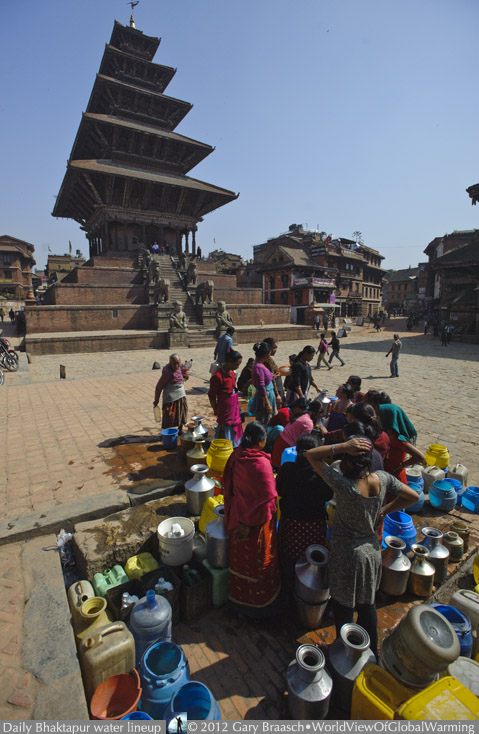
Waiting in long lines is a daily ritual for many women, in the cities as well as across the Nepalese countryside. Even though the water demand in the Kathmandu Valley is about 400 million liters per day, the public water system can provide only about 130 million in the dry season. Water is delivered by a fleet of 23 tanker trucks to some neighborhoods but the narrow streets of the old cities make that impossible. Due to the inadequate and intermittent piped water supply, as documented on the website NGO Forum on Urban Water and Sanitation, many people in the Valley, a majority of urban poor and tenants in the core city areas, are still dependent on ancient water sources such as the spouts of the hitis and dug wells to meet daily water needs.
Thanks to all the people who allowed us to photograph and speak with them, and to our guides, interpreters and drivers. Thanks again to the Karuna Foundation - US, the Uttarakhand Environmental Education Center (UEEC), World Wildlife Fund - Nepal (WWF), and The Mountain Institute. Please see other portfolios on the increasing dangers from landslides and how farmers are adapting to changing climate conditions in the Himalayas
Please see other Himalaya stories in the Climate Changes menu above.
OR
Water | Landslide | Cookstoves | Ganges Glaciers | Bhutan
COPYRIGHT NOTICE:
Photography and text Copyright © 2005 - 2017 (and before) Gary Braasch All rights reserved. Use of photographs in any manner without permission is prohibited by US copyright law. Photography is available for license to publications and other uses. Please contact requestinformation@worldviewofglobalwarming.org. View more of Gary Braasch's photography here.


